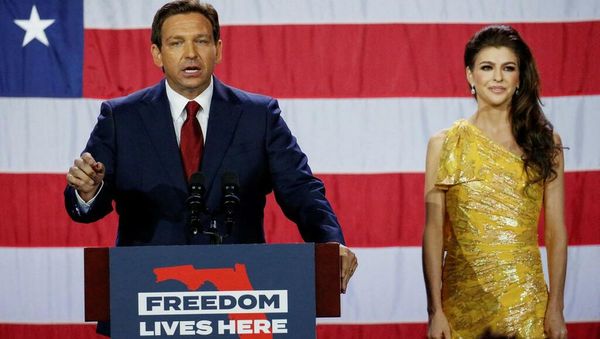MIAMI — In his victory speech Tuesday, Gov. Ron DeSantis said that his victory over Democrat Charlie Crist had “rewritten the political map.”
It wasn’t hyperbole.
The Republican governor managed to flip eight of the 13 counties he had lost in his first election in 2018 and improved his performance in each of Florida’s 67 counties.
Those gains propelled DeSantis to the most lopsided victory by a Florida governor since 1982, when Democrat Bob Graham won re-election with more than 64% of the vote in Florida.
DeSantis saw his biggest gain in Miami-Dade County, with a 16-point improvement over his 2018 performance. He also improved by nearly 16 points in Hendry County and by more than 14 points in Osceola county. They are, not coincidentally, the three most Hispanic counties in the state, and DeSantis’ ability to win a larger share of Hispanic voters was a key driver of his remarkable victory.
Fernand Amandi, one of the partners at the multilingual polling firm Bendixen & Amandi International, described DeSantis’ win on Tuesday as a “realignment election” for Florida.
“You really can’t win the state by the historic amounts that a Republican did without understanding that there was some sort of tectonic shift,” he said. “The question is, are these permanent changes?”
Amandi’s firm did Hispanic polling for Barack Obama’s two presidential campaigns and said that the Democratic campaign’s success in Florida — which it won narrowly in both 2008 and 2012 — came as a result of its success in winning over Hispanic voters, even among the reliably Republican Cuban-American community.
DeSantis’ stronger performance with Hispanic voters was, Amandi said, thanks to a sustained effort by Republicans to build broader support with those voters across the state and to broaden the party’s appeal.
Thanks in part to those efforts, Republicans overtook Democrats in overall registered voters one year ago for the first time in state history.
Al Cardenas, the former chair of the Florida Republican Party, said that declining investment in Florida by Democrats led to Tuesday’s outcome.
“Democrats abandoned Florida if you look at their spending in the state compared to the GOP,” Cardenas told the Herald on election night. “It will take more than one election cycle for Democrats to recover the lost ground.”
Amandi pointed out that a weakened Democratic party in Florida could have implications beyond the Sunshine State.
“If Republicans think and know that they don’t have to compete in Florida, that’s going to free up tens of millions of dollars,” he said. “By competing in Florida, you force the Republicans to play defense.”
Crist was able to win Gadsen, Leon, Broward, Alachua and Orange counties, but DeSantis performed far better in these Democratic strongholds than he did in 2018. The two counties in which Crist performed best — Gadsden and Leon — have a high share of Black voters, suggesting that DeSantis hasn’t had the same success winning over Black voters as he has Hispanic voters. In Miami-Dade county, however, DeSantis did improve his performance in majority-Black precincts, winning more than 16% of the vote in these precincts compared to less than 6% of the vote in these precincts in 2018.
DeSantis’ performance Tuesday only heightened the rampant speculation about whether he would run for president and take on former President Donald Trump in the Republican Primary, and offered a point of comparison with Trump’s results in the 2020 presidential election.
While the electorate in midterm elections and presidential elections is different — with midterm voters typically older and less likely to have moved recently — DeSantis also outperformed Trump’s 2020 vote share in every county in the state. His biggest increase over Trump’s 2020 performance came in Hendry County and three of the four counties in which DeSantis saw a double-digit percentage point improvement over Trump — Hendry, Hardee and Osceola — are also among the most Hispanic counties in the state.
In one respect, however, Tuesday’s election was a return to the norm: Voter turnout. While the state hasn’t released turnout numbers yet, the Herald’s analysis of final registration numbers and tallies from election day, vote by mail and early voting suggests that a bit more than 50% of registered voters cast a ballot in this year’s election, down from 63% turnout in the 2018 election, which had elevated turnout nationally as part of a Democratic wave.
———
(McClatchyDC investigative reporter Shirsho Dasgupta contributed to this report.)
———










